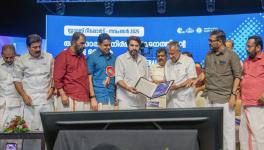Parliamentary Panel Flags Slow Increase in Health Budget
New Delhi: A Parliamentary Standing Committee has raised concerns over “less priority” being accorded to the health sector in the Budget. The committee, headed by Samajwadi Party Rajya Sabha member Ram Gopal Yadav, noted that “the budgetary allocation for the ministry of health and family welfare accounts for 2.1% of the total BE 2022-23 (Budget Estimates for 2022-2023) whereas the allocation for the ministry of defence is 13.3% of the total budgeted expenditure of the government in 2022-23”.
The 134th Report of the Standing Committee on Health and Welfare, tabled in the Rajya Sabha on March 24, observed: “The committee realises that for a country like India with limited state and Central government funds, mobilisation of resources poses a big challenge. However, this should not deter the governments from increasing their health expenditure and according less priority to the health sector.”
An analysis of the Budget provisions for ministries shows that India would spend six times (6.09 times to be precise) more on defence than on healthcare in 2022-2023. The allocation for defence this financial year is Rs 5,25,166.15 crore while the health budget is only Rs 82,600.65 crore. The total budget expenditure for 2022-2023 is Rs 39.45 lakh crore. Last year, the allocation for health was Rs 73,931.77 crore while the defence budget was Rs 4,78,195.62 (6.46 times more than health).
The committee further said that it is “not happy with the slow trend of increase in the share of the health budget”. As compared to the revised health budget for 2021-2022 of Rs 86000.65 crore, the allocation for health in 2022-2023 was only increased by Rs 200 crore.
The committee, comprising 30 members, including 13 from the Bharatiya Janata Party (BJP), also took notice of the “poor state of health infrastructure” and expressed disappointment with the government’s lack of will for strengthening the health sector in wake of COVID-19. “The pandemic brought forth in open the poor state of health infrastructure and necessitated government’s focus and policy intervention to bridge infrastructure gaps to strengthen the healthcare facilities. It was anticipated that the ravages of the pandemic will bring the attention of the government to the rural-urban divide in healthcare services and their delivery.”
The committee noted that despite the pandemic exposing the poor state of health infrastructure, “just a 0.2 % increase in the BE of 2022-23 in comparison to RE 2021-22 (Revised Estimates) reveals the reluctance of the government in addressing the immediate need of increasing public investment in the health sector”.
Meanwhile, the increase in the defence budget in 2022-2023 was 4.43% more than the revised defence budget for 2021-2022 (which was Rs 5,02,883.54 crore), the report stated.
It is important to note that in the 2022-2023 Budget, the BJP government’s flagship scheme Ayushman Bharat Pradhan Mantri Jan Arogya Yojana (PM-JAY) was allotted Rs 6,412 crore despite low utilisation of funds in 2021-2022. Last year, against the allotted budget of Rs 6,400 crore for the scheme, the health ministry revised the scheme’s budget to just Rs 3,199 crore—less than half of the initial allotment.
Taking note of how high expenditure on health can drive people towards economic distress, the committee also noted: “Health is one sector that can drive people to poverty and disrupt the economic conditions of families. The attention of the committee has also been brought to the tracking of universal health coverage: 2017 Global Monitoring Report by WHO and World Bank, which states, ‘Average 4.16 % of the population annually slips into poverty due to catastrophic health expenditure.’”
According to the latest World Bank data, private health expenditure in 2019 constituted a whopping 66.3% of current health expenditure. This included expenditure by households, corporations and non-profit organisations. India’s public health expenditure as a percentage of current health expenditure was lower than that of Sri Lanka, Bhutan and China, among its neighbours. India’s public expenditure on health when compared to total expenditure on health is one of the lowest in the world.
The committee reemphasised that the “importance of health sector must not be ignored and health must be given priority in terms of budgetary allocation”. According to the latest National Health Accounts Estimates for India, for the financial year 2015-2016 (prepared by the ministry of health and family welfare and released in November 2018), the per capita government health expenditure was Rs 1,261 while per capita out-of-pocket expenditure was Rs 2,494.
The committee also flagged that except for Delhi and Puducherry, none of the states had enhanced the share of the health budget to more than eight per cent of their total budget in the last five years.
The writer is a Delhi-based independent researcher.
Get the latest reports & analysis with people's perspective on Protests, movements & deep analytical videos, discussions of the current affairs in your Telegram app. Subscribe to NewsClick's Telegram channel & get Real-Time updates on stories, as they get published on our website.
























